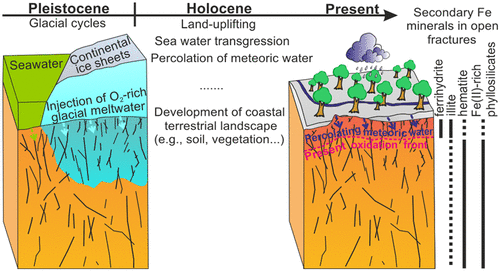当前位置:
X-MOL 学术
›
Environ. Sci. Technol.
›
论文详情
Our official English website, www.x-mol.net, welcomes your feedback! (Note: you will need to create a separate account there.)
A Combined X-ray Absorption and Mössbauer Spectroscopy Study on Fe Valence and Secondary Mineralogy in Granitoid Fracture Networks: Implications for Geological Disposal of Spent Nuclear Fuels.
Environmental Science & Technology ( IF 11.4 ) Pub Date : 2020-02-17 , DOI: 10.1021/acs.est.9b07064 Changxun Yu 1 , Henrik Drake 1 , Knud Dideriksen 2 , Mikael Tillberg 1 , Zhaoliang Song 3 , Steen Mørup 4 , Mats E Åström 1
Environmental Science & Technology ( IF 11.4 ) Pub Date : 2020-02-17 , DOI: 10.1021/acs.est.9b07064 Changxun Yu 1 , Henrik Drake 1 , Knud Dideriksen 2 , Mikael Tillberg 1 , Zhaoliang Song 3 , Steen Mørup 4 , Mats E Åström 1
Affiliation

|
Underground repository in crystalline bedrock is a widely accepted solution for long-term disposal of spent nuclear fuels. During future deglaciations, meltwater will intrude via bedrock fractures to the depths of future repositories where O2 left in the meltwater could corrode metal canisters and enhance the migration of redox-sensitive radionuclides. Since glacial meltwater is poor in reduced phases, the quantity and (bio)accessibility of minerogenic Fe(II) in bedrock fractures determine to what extent O2 in future meltwater can be consumed. Here, we determined Fe valence and mineralogy in secondary mineral assemblages sampled throughout the upper kilometer of fractured crystalline bedrock at two sites on the Baltic Shield, using X-ray absorption and Mössbauer spectroscopic techniques that were found to deliver matching results. The data point to extensive O2-consuming capacity of the bedrock fractures, because Fe(II)-rich phyllosilicates were abundant and secondary pyrite was dispersed deep into the bedrock with no overall increase in Fe(II) concentrations and Fe(II)/Fe(III) proportions with depth. The results imply that repeated Pleistocene deglaciations did not cause a measurable decrease in the Fe(II) pool. In surficial fractures, largely opened during glacial unloading, ferrihydrite and illite have formed abundantly via oxidative transformation of Fe(II)-rich phyllosilicates and recently exposed primary biotite/hornblende.
中文翻译:

花岗岩断裂网络中铁价和次生矿物学的X射线吸收和Mössbauer光谱相结合的研究:对废弃核燃料的地质处置的意义。
结晶基岩中的地下资源库是长期处理乏核燃料的公认解决方案。在未来的冰期中,熔体水将通过基岩裂缝侵入到未来的储层深度,在熔体中残留的O2可能腐蚀金属罐并增强对氧化还原敏感的放射性核素的迁移。由于冰川融化水在还原相中很差,因此基岩裂缝中成矿的Fe(II)的数量和(生物)可及性决定了未来融化水中O2的消耗量。在这里,我们使用X射线吸收法和Mössbauer光谱技术确定了波罗的海盾上两个位置的整个裂隙结晶基岩上公里的次生矿物组合中的Fe价和矿物学,发现该方法可提供匹配的结果。数据表明基岩裂缝具有广泛的O2吸收能力,因为富含Fe(II)的层状硅酸盐丰富,次生黄铁矿分散在基岩深处,而Fe(II)浓度和Fe(II)/ Fe并未总体增加(三)深度配合。结果表明,重复的更新世冰期并没有导致Fe(II)库的可测量减少。在表面裂缝中,在冰川卸荷过程中大部分打开,通过富铁(II)的层状硅酸盐的氧化转化以及最近暴露的主要黑云母/角闪石,大量形成了水铁矿和伊利石。因为富含Fe(II)的层状硅酸盐丰富,次生黄铁矿分散在基岩深处,但Fe(II)浓度和Fe(II)/ Fe(III)的比例并未随深度整体增加。结果表明,重复的更新世冰期并没有导致Fe(II)库的可测量减少。在表面裂缝中,在冰川卸荷过程中大部分打开,通过富铁(II)的层状硅酸盐的氧化转化以及最近暴露的主要黑云母/角闪石,大量形成了水铁矿和伊利石。因为富含Fe(II)的层状硅酸盐丰富,次生黄铁矿分散在基岩深处,但Fe(II)浓度和Fe(II)/ Fe(III)的比例并未随深度整体增加。结果表明,重复更新世的冰期并没有导致Fe(II)库的可测量减少。在表面裂缝中,在冰川卸荷过程中大部分打开,通过富铁(II)的层状硅酸盐的氧化转化以及最近暴露的主要黑云母/角闪石,大量形成了水铁矿和伊利石。
更新日期:2020-02-17
中文翻译:

花岗岩断裂网络中铁价和次生矿物学的X射线吸收和Mössbauer光谱相结合的研究:对废弃核燃料的地质处置的意义。
结晶基岩中的地下资源库是长期处理乏核燃料的公认解决方案。在未来的冰期中,熔体水将通过基岩裂缝侵入到未来的储层深度,在熔体中残留的O2可能腐蚀金属罐并增强对氧化还原敏感的放射性核素的迁移。由于冰川融化水在还原相中很差,因此基岩裂缝中成矿的Fe(II)的数量和(生物)可及性决定了未来融化水中O2的消耗量。在这里,我们使用X射线吸收法和Mössbauer光谱技术确定了波罗的海盾上两个位置的整个裂隙结晶基岩上公里的次生矿物组合中的Fe价和矿物学,发现该方法可提供匹配的结果。数据表明基岩裂缝具有广泛的O2吸收能力,因为富含Fe(II)的层状硅酸盐丰富,次生黄铁矿分散在基岩深处,而Fe(II)浓度和Fe(II)/ Fe并未总体增加(三)深度配合。结果表明,重复的更新世冰期并没有导致Fe(II)库的可测量减少。在表面裂缝中,在冰川卸荷过程中大部分打开,通过富铁(II)的层状硅酸盐的氧化转化以及最近暴露的主要黑云母/角闪石,大量形成了水铁矿和伊利石。因为富含Fe(II)的层状硅酸盐丰富,次生黄铁矿分散在基岩深处,但Fe(II)浓度和Fe(II)/ Fe(III)的比例并未随深度整体增加。结果表明,重复的更新世冰期并没有导致Fe(II)库的可测量减少。在表面裂缝中,在冰川卸荷过程中大部分打开,通过富铁(II)的层状硅酸盐的氧化转化以及最近暴露的主要黑云母/角闪石,大量形成了水铁矿和伊利石。因为富含Fe(II)的层状硅酸盐丰富,次生黄铁矿分散在基岩深处,但Fe(II)浓度和Fe(II)/ Fe(III)的比例并未随深度整体增加。结果表明,重复更新世的冰期并没有导致Fe(II)库的可测量减少。在表面裂缝中,在冰川卸荷过程中大部分打开,通过富铁(II)的层状硅酸盐的氧化转化以及最近暴露的主要黑云母/角闪石,大量形成了水铁矿和伊利石。



























 京公网安备 11010802027423号
京公网安备 11010802027423号